January
11, 1923 - Leesburg, Texas.
Carroll Hall Shelby is born to Warren Hall Shelby, a rural mail carrier,
and Eloise Lawrence Shelby.
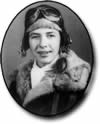
November 1941
- Begins training at Lackland Air Force Base near San Antonio, TX. On
training missions, Carroll corresponds with his fiancee by dropping love
letters placed in his flying boots, onto her farm. As a flight
instructor, he did not leave the U.S. during WW II.
December 18, 1943
- Carroll Shelby marries Jeanne Fields.
December 27, 1944
- Sharon Anne Shelby is born.
August 1945 -
Carroll leaves the Air Corps for civilian life and starts a dump truck
business in Dallas, TX.
November 2, 1946
- Michael Hall Shelby is born.
October 23, 1947
- Patrick Burke Shelby is born.
1949 - Carroll
goes into the chicken raising business. His first batch of broilers nets
a $5000 profit, but he goes bankrupt when his second group of chickens
die of Limberneck disease.
January 1952 -
Carroll drives in his first race, a quarter-mile drag meet, behind the
wheel of a hot rod fitted with a flathead Ford V8.
May 1952 - At
Norman, Oklahoma, Carroll drives in his first road race behind the wheel
of an MG-TC, taking first place in competition with other MGs. The same
day, against hotter competition from Jaguar XK 120s, he wins again!
November 1952 -
Carroll Shelby pilots a Cad-Allard to first place in an early SCCA race
on a road racing course set up near the little town of Caddo Mills, TX.
August 1953 -
Carroll Shelby realizes he'll have to hurry to the track to get in any
practice and wears his work clothes-coveralls-from the farm. When his
odd racing attire nets him more laughs and publicity than his racing
record, Carroll sticks with the striped bib coveralls, which become his
trademark.
January 1954 -
Shelby attracts the attention of John Wyer, Aston Martin's team manager
and meets International Grand Prix driving greats Juan Fangio and Peter
Collins. On the strength of Shelby's racing expertise behind the wheel
of the Cad-Allard, Wyer Invites Shelby to co-drive an Aston -Martin DB3
at Sebring, Florida.
April 1954 -
Shelby goes to Europe and drives an Aston-Martin DBR3 for Wyer,
finishing a very respectable second against C-Type Jags at Aintree,
leading to a ride with the Aston-Martin team at Le Mans in June 1954,
co-driving with Paul Frére. Shelby continues to race Aston-Martins in
Europe for 1954, returning to the States in August.
August 1954 -
Donald Healey of Austin-Healey in England, invites Carroll Shelby to
help set 70 new Class D records at the Bonneville Salt flats in Utah.
November 1954 -
Carroll Shelby enters the Carrera Pan Americana Mexico. At the
175-kilometer marker north of Oaxaca, Shelby T-bones a large rock and
flips his Austin-Healey four times. Indians find him and offer him
strong drinks to ease the pain of his broken bones, cuts, contusions,
and a shattered elbow.
March 1955 -
Although Shelby was still undergoing operations to recover from his
racing accident, he continued to race with his arm in a specially made
fiberglass cast and his hand taped to the steering wheel. At Sebring,
Shelby co-drives a 3.0-liter Monza Ferrari with Phil Hill.
July 1955 -
Shelby wins the Torrey Pines race with a 4.1-liter Mexico Ferrari,
defeating Phil Hill. Tony Paravano, a building contractor in Los Angeles
takes notice and asks Shelby to drive a new 4.9-liter 12-cylinder
Ferrari. Shelby wins in his first outing and is then asked to go to
Europe to race.
1956 - Sports
Illustrated names Shelby sports car driver of the year.
Early 1957 -
Carroll Shelby Sports Cars opens at 5611 Yales in Dallas, Texas, with
backing from Dick Hall, an oilman from Abilene, Texas, and brother of
Jim Hall who built the Chaparral cars.
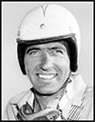 March 1957
- Sports Illustrated names Shelby "Driver Of The Year."
March 1957
- Sports Illustrated names Shelby "Driver Of The Year."
November 1957 -
Shelby, driving a double-overhead-camshaft V8 Maserati single-seat
racing car, wins a 100-mile race at Riverside. After spinning out on the
first lap, he went to the back of the field, then lapped everybody in
one of the most amazing feats of his career.
June 1959 -
Carroll and Ray Salvadori co-drive an Aston Martin DBR1/300 and win the
24 Hours of LeMans.
January 1960 -
Carroll Shelby begins his last racing season in a Maserati 250F Formula
One Grand Prix car formerly driven by Fangio at Rheims in 1958.
February 1960 -
While staying at a friend's apartment in Dallas, Shelby experiences
chest pains and begins slipping nitroglycerin pills under his tongue for
relief. His doctor incorrectly diagnoses the problem unrelated to the
heart. Carroll moves to La Mirada, California, and separates from his
wife, Jeanne, who stays in Dallas with the three kids. Shelby opens his
Goodyear Racing Tire distributorship.
May 1960 -
Doctors diagnose Shelby's chest pains as "angina pectoralis," in which
the coronary arteries are starved for blood.
June 27, 1960 -
Carroll Shelby, driving a Scarab to first place at Continental Divide
Raceways, breaks a course record and sets his sights on the USAC driving
championship.
December 3-4, 1960
- Shelby competes in his last race, the Third Annual Los Angeles
Times-Mirror Grand Prix for sports cars, driving a Type 61 Birdcage
Maserati, and finishing fifth. Overall, he wins the USAC driving
championship for 1960.
1961 - Out of
racing, Shelby pursues another career and opens his "Shelby School of
High Performance Driving." A $90 ad in Sports Car Graphic returns $1400
in requests for literature. Pete Brock, a talented automotive designer,
stylist, and driver prepares the curriculum and helps with the teaching
duties.
September 1961
- When AC Cars of Thames Ditton, England, loses the source for its
six-cylinder Bristol engine for its two-seat roadster, Carroll Shelby
airmails a letter of proposal to the company to keep building the
chassis for a special Shelby sports car to be powered by an American V8.
As yet, he knows nothing of a new lightweight, thinwall-cast,
small-block Ford V8.
October 1961 -
Charles Hurlock, owner of AC Cars, returns Shelby's letter, stating he
would be interested in Shelby's plan as long as a suitable engine
replacement could be found in the States. The same month, Shelby finds
out about the new 221-cube Ford small-block and dispatches a letter to
Dave Evans explaining his idea for a sports car and his need for a V8.
February 1962 -
The first 260 Roadster, minus engine and transmission, is air freighted
on February 2, 1962, to Shelby's shop in Southern California. Carroll
has a dream revealing to him the name Cobra appearing on the front of
his car. In Carroll's words, "I woke up and jotted the name down on a
pad which I kept by my bedside-a sort of ideas pad- and went back to
sleep. Next morning when I looked at the name 'Cobra,' I knew it was
right." In less than eight hours, a 260 HiPo and Borg-Warner four-speed
are installed and Shelby and friend Dean Moon test drive the new Cobra,
looking to bait Corvettes, but none are found.
March 1962 -
Shelby-American begins operations at a shop on Princeton Drive in
Venice, California, and hires Ray Geddes, a Ford finance business school
graduate who comes aboard at Shelby-American to coordinate the program
with Ford. Among his first duties are his efforts to keep Ford's
involvement at a low profile due to Ford's liability concerns.
 Shelby
creates the original Cobra Roadster. Fatest production car ever made at
that time; 0-60 in 3.9 seconds.
Shelby
creates the original Cobra Roadster. Fatest production car ever made at
that time; 0-60 in 3.9 seconds.
April 1962 -
CSX 2000, the first Cobra, is painted a pearlescent yellow by Dean
Jeffries and shipped to the New York Auto Show where it appears in the
Ford display. Dealers begin ordering and with deposits in the bank,
Shelby-American formally commits to building its new Cobra.
May 1962 -
Shelby promotes his Cobra by offering test drives to the automotive
press, who respond with superlatives. The May 1962 issue of Sports Car
Graphic describes its acceleration as explosive. CSX 2001 (the second
Cobra built) is shipped by air from England (minus engine, transmission,
and rear end) to New York and is prepared by Ed Hugus in Pittsburgh,
Pennsylvania. CSX 2002 is air freighted to Los Angeles and built into
the first competition Cobra.
June 1962 -
Production is slow as Shelby-American wrestles with start-up problems
due to the fact that the AC chassis requires extensive engineering.
Meanwhile, CSX 2000 is repainted a different color each time a different
magazine test drives it, giving the appearance of many cars in
production. The Cobra has a 1-ton advantage over the Corvette.
August 1962 -
Shelby-American submits papers to homologate the Cobra as a GT III car
in the eyes of the FIA, the Federation Internationale de L'Automobile.
On August 6, the FIA homologates the Cobra in the more-than 2-liter
class for the FIA Manufacturers' Championship. At least 100 cars had to
be built within 12 months, but at the time of approval, just eight
Cobras had been completed. According to Carroll, he contemplated
switching the chassis and body to an alternative due to continued
problems.
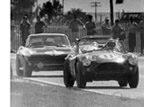
October 13, 1962
- Shelby-American enters the Cobra in its first race, a
three-hour contest with Bill Krause behind the wheel, opening the Los
Angeles Times Grand Prix. Krause, with a poor start, falls back, then
takes the lead at lap nine, but breaks a rear hub and does not finish.
The Cobra, however, is definitely lighter and faster than the new
Corvette Stingray. Phil Remington at Shelby-American goes to work
building stronger rear hubs starting with forging blanks from Halibrand.
January 1963 -
Dave MacDonald and Ken Miles sign to drive Cobras for Shelby-American
and place first and second at Riverside, beating the Corvette Stingrays.
Miles is so confident, he pits for a drink of water and relaps the
Corvettes to finish behind MacDonald. Ian Garrad, an Englishman living
Southern California, feels he could imitate the Cobra with a 260 Ford
version of the little four-cylinder British Sunbeam Alpine roadster. Ken
Miles is first hired to build a prototype "Tiger," a job that is handed
over to Shelby-American.
February 1963 -
Shelby-American arrives at Daytona for its first international
competition. The Ferrari GTO triumphs, after Daytona, Chevrolet drops
out of racing.
March 1963 -
Shelby-American enters four cars at Sebring, Florida, an FIA race. Two
of the four have the new rack-and-pinion steering--driven by Dan Gurney
and Phil Hill. Although Hill sets the fastest GT lap, the Ferraris win.
June 1963 -
Shelby-American completes its first 125 Cobras. Because Ford refuses to
finance a Cobra Le Mans effort, Shelby puts together a deal with AC Cars
and Ed Hugus, who prepare one car each. The top Cobra finishes seventh.
 September
1963 - Shelby begins the Daytona Coupe project, for the roadster
lacks the aerodynamics necessary for 200mph down the Mulsanne Straight.
Pete Brock is the designer. Cobra production passes 170. The first
Cooper Monacos -King Cobra- are ordered. Dan Gurney, in winning the
Bridgehampton 500KM in a Cobra, becomes the first American driver to win
an FIA race in an American car.
September
1963 - Shelby begins the Daytona Coupe project, for the roadster
lacks the aerodynamics necessary for 200mph down the Mulsanne Straight.
Pete Brock is the designer. Cobra production passes 170. The first
Cooper Monacos -King Cobra- are ordered. Dan Gurney, in winning the
Bridgehampton 500KM in a Cobra, becomes the first American driver to win
an FIA race in an American car.
November 1963 -
The Cobra does not beat Ferrari in international competition in 1963, it
dominates the Corvette and wins the SCCA A-production national
championship.
December 1963 -
The Cobra wins the USRRC (United States Road Racing Championship).
February 1964 -
Shelby-American completes the first FIA roadster and the first Daytona
Coupe, both enter the Daytona Continental. Bob Johnson and Dan Gurney
finish fourth in an FIA Cobra roadster, Although the Cobra coupe sets
the fastest lap time, it is a DNF due to a damaged differential and a
fire.
March 1964 -
Shelby-American enters a 427-engined leaf-spring Cobra, CSX 2166, at
Sebring in the prototype class. Ken Miles spins off course in practice
and hits the one tree in sight, but the 427 test mule is fixed for the
race the next day. The Cobras, for the first time, beat the Ferrari GTOs.
At Sebring, Carroll Shelby meets with the Hurlock Brothers from AC Cars
and Ford design engineer Klaus Arning to develop a big-block Cobra.
April 1964 -
After Sebring, Cobra led Ferrari in FIA points for the GT III
championship, and Shelby-American decides to go to Europe to race. Two
months before Le Mans, the Sarthe circuit is closed off for testing. The
Cobras and Ford's new GT-40 are tested at Le Mans. Later, on April 26,
the Cobra competes at the Targa Floria. Oddly, the new Porsche 904s
triumph over Ferrari, followed by the Cobra.
June 1964 - The
Cobras and Shelby-American win the biggest race of all in Europe, the 24
Hours of Le Mans. The Cobra is fourth overall and first in GT, defeating
Ferrari.
August 1964 -
Ford asks Carroll Shelby to develop a high-performance Mustang fastback
for street and track. Basically, the new car would challenge the
Corvette in SCCA B-production road racing. The Cobras score in Europe at
the Freiburg Hill climb in the Black Forest, at the Tourist Trophy in
Goodwood, England, and at the Sierre-Montana Grand Prix De La Montagne
in the Swiss Alps.

September 1964
- The first '65 Shelby Mustang GT350 race cars and street cars are
built.
October 1964 -
The prototype 427 Cobra, under development, is tested at Silverstone in
England and later in the States.
November 1964 -
Shelby-American completes the 427 Cobra prototype. The 289 Cobra
Roadster again wins the SCCA A-production national championship.
December 1964 -
The SCCA accepts the GT350 in the B-production road racing class, as
cars are being completed at the Venice, California shop of
Shelby-American. Enzo Ferrari holds his annual press conference and
announces he will not contest the GT III championship without his LM
Ferrari, in effect, giving no factory Ferrari competition to the Cobra
team for the upcoming 1965 FIA season.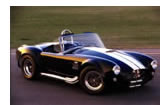
January 1965 -
The 427 Cobra, featuring a tube frame, aluminum body, and coil spring
chassis, is unveiled at a press introduction at Riverside International
Raceway. Shelby-American begins its move to Los Angeles International
Airport facility. Ford turns its GT-40 project over to Shelby-American.
The 1965 GT350 debuts.
February 1965 -
With Shelby handling the racing program, Ford's GT-40, painted in Shelby
Guardsman Blue with two white stripes, wins its first race, at Daytona.
The Shelby Mustang GT350 also wins its first race, at Green Valley,
Texas. Shelby-American begins production of its Ferrari-beating missile,
the coupe version of the 427 Cobra Roadster. At Daytona, the Cobra
Daytona Coupe, with Jo Schlesser and Harold Keck driving, is first in
the GT class.

March 1965 -
Production of the GT350 moves to Los Angeles International Airport after
the first 250 cars are completed. The GT-40 Mark II (427 big-block) is
under development. Jo Schlesser and Bob Bondurant pilot the Cobra
Daytona Coupe to first overall in the Sebring 12-Hours.
April 1965 -
The Cobra team flies to Europe to continue its winning season. With team
Ferrari out of the picture, Shelby-American is dominating. Bondurant and
Grant are first at Monza, Italy, in the Daytona Coupe. Meanwhile, the
FIA denies the 427 Cobra certification because 100 cars are not
finished. The first 427 street Cobra is finished.
May 1965 - At
Oulton Park, England, Sir John Whitmore takes first in the GT class in a
Cobra Daytona Coupe. Bondurant is second in a Coupe at Spa, Belgium.
Back home, the first GT350 drag car is built.
June 1965 -
Shelby-American and Ford stage an assault on Le Mans with two 427 GT-40
Mark IIs, four 289 GT-40 Mark Is, and five Cobra Daytona Coupes. The
GT-40s all drop out, while one Daytona Coupe finishes.

July 4, 1965 -
Shelby-American, racing Cobras at the 12 Heures De Reims in France,
scores enough points to assure the FIA World Championship of GT cars,
wrestling the title virtually owned by Ferrari for more than a decade.
The Paxton supercharger GT350 prototype is completed. Shelby Cobra
Daytona Coupe, the only American car ever to win the FIA World's
Manufacturer's Championship for GT cars, beating Europe's best; Porsche,
Ferrari, Jaguar, and Aston Martin.
August 1965 -
Production of the '66 GT350 is underway. The first 15 competition 427
Cobras are delivered to customers for SCCA A-production racing.
October 1965 -
The brand-new '66 GT350 Shelby fastbacks go on sale, and Shelby-American
proposes a special Hertz racer. A prototype GT350H is built.
November 1965 -
Hertz likes the GT350H and gives Shelby-American a contract for 200
cars. The FIA certifies the 427 for the 1966 racing season, and the '66
GT350 again wins the national B-production road racing championship in
the SCCA.
December 1965 -
Hertz ups its contract for GT350H models to 1000 units.
February 1966 -
The Ford GT-40 Mark II wins at Daytona. Shelby-American builds a Mustang
notchback prototype for the brand-new Trans-Am racing series.
June 1966 -
Henry Ford II watches proudly as a trio of GT-40 Mark IIs cross the
finish line at Le Mans, 1-2-3. The specifications for the '67 GT350 and
new GT500 are finalized.
August 1966 -
Ken Miles is killed at Riverside International Raceway.
September 1966
- 1967 production begins at LAX (Los Angeles International Airport).
Jerry Titus wins at Riverside and Ford wins the Trans-Am Manufacturer's
title.
November 1966 -
The first of the '67 Shelby GT350s and GT500s are delivered to dealers
nationwide.
March 1967 -
The last 427 Cobra Roadster is built.
June 1967 -
Ford again wins at Le Mans with its Mark IV GT-40.
August 1967 -
Shelby-American loses the lease on its LAX facility.
September 1967
- Production of '68 Shelby Mustang moves to Ionia, Michigan, and the
A.O. Smith Company. The Lone Star, to be the successor to the Cobra,
constructed in England by John Wyer's JW Automotive Engineering.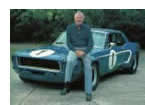
October 1967 -
Shelby-American takes the '67 Trans-Am Manufacturer's title for Ford.
Shelby-American completes construction of a Cougar-Cobra Can-Am racing
car.
November 1967 -
Shelby-American racing moves to Torrance, California, as '68
Shelby production begins. he '68 Shelby Mustang convertible joins the
lineup. Shelby holds his first Chill
cook-off.
June 1968 - The
'69 Shelby GTs are finalized. Again, a GT-40 takes first place at Le
Mans.
August 1968 -
The last brand-new 427 Cobra Roadster is sold by Shelby.
September 1968
- Shelby opens a Ford dealership in Lake Tahoe, California.
October 1968 -
The only Lone Star is offered for sale for $15,000, the price it was to
retail for if it had made production.
 November 1968
- The 1969-model year Shelby Mustang production begins.
November 1968
- The 1969-model year Shelby Mustang production begins.
May 1969 - At
Lime Rock, in the Trans-Am racing series, Sam Posey pilots a Shelby team
car to the company's last Ford victory.

August 1969 -
Carroll Shelby begins marketing his famous Chili mix.
September 1969
- The Shelby Mustang project is ended as sales slow dramatically. The
leftover '69 models are updated to '70 specifications and production
ends.
October 1969 -
At Riverside, in the Trans-Am, Shelby fields his last Ford team race
car.
December 1969 -
Shelby Automotive Racing Company closes.
February 1970 -
Ford ends its long-term racing agreement with Carroll Shelby.
January 1973 -
The Shelby-Dowd Wheel Company is started.
September 1975
- The Shelby-American Automobile Club (SAAC) is started.
August 19-21, 1976
- SAAC-1, the first annual convention of the Shelby Automobile Club of
America is held in Oakland, California. About 600 people attend. It's
the first time since the Sixties that Carroll Shelby gets together with
his team drivers, such as Lew Spencer and Bob Bondurant.
October 1982 -
Carroll Shelby contracts with Chrysler to create performance cars based
on Dodge products.
 November
1982 - Prototype Dodge Shelby Chargers are built and displayed.
November
1982 - Prototype Dodge Shelby Chargers are built and displayed.
July 1986 -
Shelby sells his chili company to Kraft.
1987 - Shelby envisions and begins
prototype work on a Dodge sports car which later becomes the "Viper."
April 1988 -
Shelby sues Ford for using GT350 for its '84 Anniversary Mustang.
1989 -
Shelby produces the Cobra 427 S/C Completion Cars. Shelby builds the
first Viper chassis prototype.
January 1989 - The Viper is first
shown at the
Detroit Automobile Show.
 Shelby is
there.
Shelby is
there.
November
1989 - Shelby begins his 427 Cobra S/C project, continuing
production of "leftover" S/C models from 1966.
March
1990 - The lawsuit with Ford is resolved.
June 1990 -
Carroll Shelby receives the heart of a 38-year-old gambler from Las
Vegas in a long-awaited and overdue transplant operation.
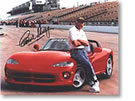 May
1991 - Less than a year after his transplant, a hale and hearty
Carroll Shelby paces the Indy 500 in a Dodge Viper. Shelby takes the
physical exam and doctors say his heart is as strong as the drivers in
the front row of the race.
May
1991 - Less than a year after his transplant, a hale and hearty
Carroll Shelby paces the Indy 500 in a Dodge Viper. Shelby takes the
physical exam and doctors say his heart is as strong as the drivers in
the front row of the race.
September 1991
- Carroll Shelby starts the Carroll Shelby Children's Foundation that
funds heart transplants for indignet children. Shelby inducted into
International MotorSports Hall of Fame.
November 1991 -
The Palm Springs Vintage Road Races feature the cars of Shelby-American
and honor Carroll with a dinner featuring his life long buddies and
friends. Proceeds go to the Shelby Heart Fund.
July 1992 - At
SAAC-17 (17th annual convention of the Shelby American Automobile Club),
Carroll Shelby gives club members high-speed rides around the racetrack
in his new 427 S/C Cobra.
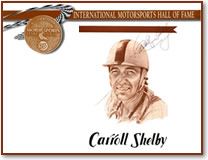
September 1992 - At the Fall
Festival at Lime Rock, Shelby races a '65 Shelby "R" model GT350 for the
first time, a car belonging to SAAC's Rick Kopec. Shelby, now 69 years
old, runs 1:09 lap times, just 0.4 second off the record set in '65 by
Bob Johnson in a '65 R-model Shelby.
October 1, 1992 - Carroll Hall
Shelby is elected to the
Automotive Hall of Fame in ceremonies at the Westin Hotel in
Detroit, Michigan.
December
30, 1992 - Shelby helps introduce the Viper concept coupe at the
Los Angeles Auto Show.
1995 - Shelby produces CSX4000
Series 427 Cobra S/C Roadsters.
1997
- Shelby designs and manufacturers the Shelby Series 1 sports car.
1998
- Shelby creates the (Super Pursuit) S.P. 360 high performance sport
utility vehicle.
1999
- Shelby Cobra CSX2000' Motor Trend Magazine's most significant car of
the last 50 years. Shelby teams with Titan to produce Shelby custom
motorcycle; Shelby Series 1 by Titan.
2000
- Shelby expands activities. . . details to follow. . .
2003 - Series II is announced & Supercharged 427 FE motor debuts as
well.

"
Celebrating 70 Years Of A Timeless Classic, Carroll Shelby" by
Jerry Heasley
Thank you to Rick Kopek
and the Shelby American Automobile Club for their help in providing the
historic information presented here as well as Carroll Shelby.